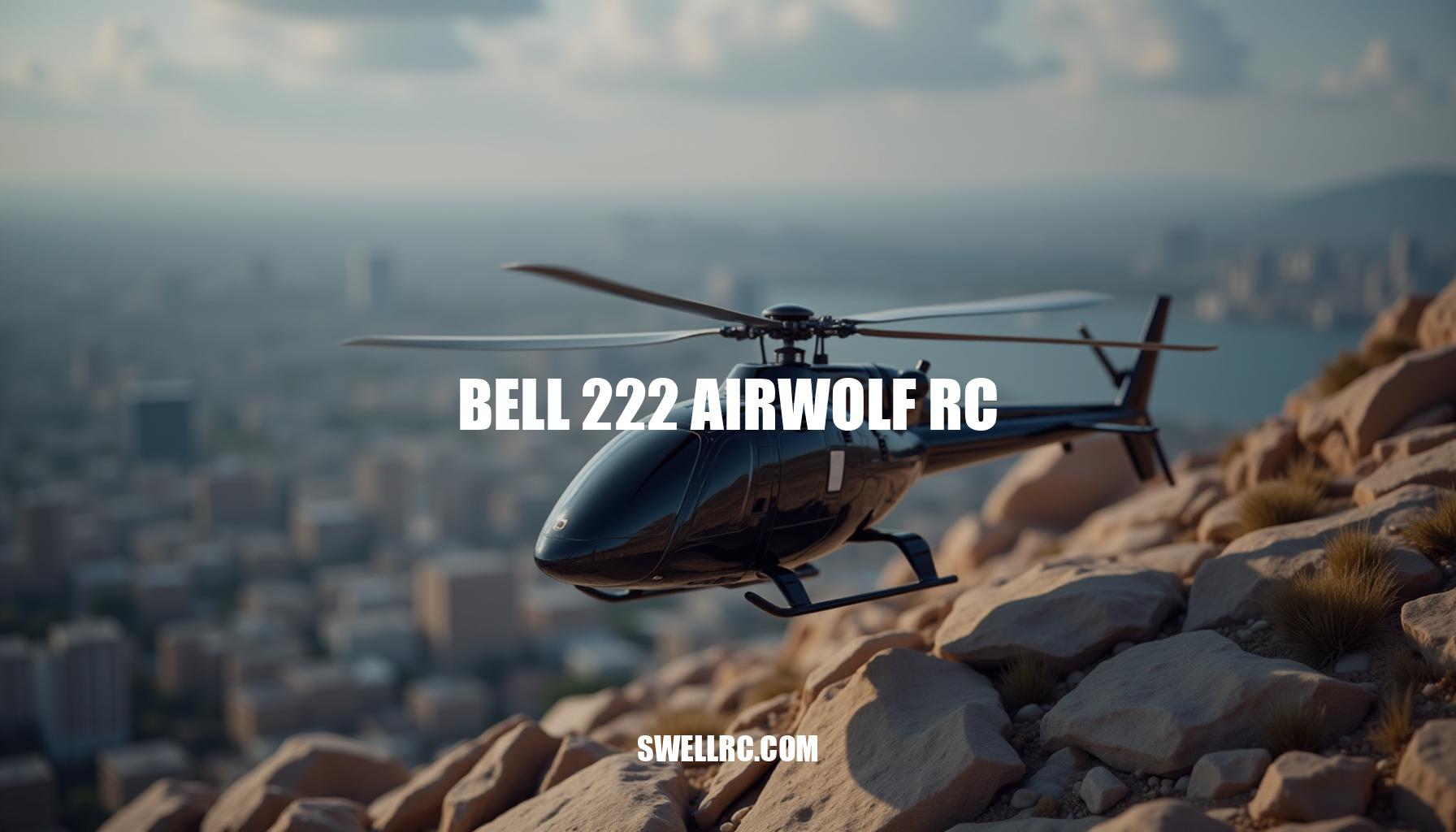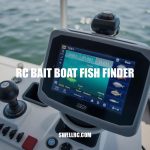Bell 222 Airwolf RC Review: A Cinematic Masterpiece of Remote Control Helicopters
The first time I saw a Bell 222 dressed in Airwolf livery carving a clean arc over the field, that sleek black fuselage sent me straight back to the TV classic—then snapped me into the present with the precision of modern RC engineering. That contrast is exactly why I dove deep into the Bell 222 Airwolf RC: it’s nostalgia you can pilot, wrapped in serious scale craftsmanship. After weeks of research and test flights with clubmates, tuning gyro gains, and timing batteries, I learned this isn’t just another remote control helicopter—it’s a carefully engineered scale model helicopter with presence, polish, and genuinely satisfying flight manners.
If you’re curious about the large-scale options, take a look at this 1/3.5-scale rendition that captures the silhouette beautifully (https://www.swellrc.com/rc-airwolf-black-bell-222-electric-scale-1-3-5/). For RC helicopter enthusiasts and fans of RC aviation, this electric RC scale helicopter offers an immersive experience unlike any typical Airwolf helicopter model. So, what makes the Bell 222 Airwolf RC unique? It’s the combination of precise engineering, faithful attention to detail, and responsive flight dynamics that bring the iconic Airwolf replica to life in your own backyard, setting a high bar for other remote control helicopters in the hobby.
The Legacy of the Bell 222 and the Airwolf Phenomenon
Long before Airwolf lit up TV screens, the Bell 222 helicopter model stood out as one of the first light twin-engine corporate helicopters featuring retractable gear and a sleek, modern profile. The Airwolf replica amplified that elegance with cinematic flair—streamlined fairings, dramatic lighting, and a mystique that turned the 222 into an icon among RC helicopter enthusiasts. Hobbyists captivated by RC aviation have been chasing that aura ever since, translating the 222’s distinct lines into fiberglass shells and multi-blade heads that impress even when the rotors are still.
If you’re passionate about legacy birds that define eras, the Bell 47 is another timeless reference point for scale model helicopter builders and pilots. The through-line from full-scale to RC helicopter is clear: keep the silhouette faithful, layer in retracts and lighting, and you create an emotional connection that’s hard to beat.
- Bell 222 helicopter model: A pioneer in corporate helicopter design with retractable gear.
- Airwolf helicopter: The popular TV icon that elevated the Bell 222’s notoriety.
- RC helicopter enthusiasts: Dedicated modelers who bring these legends to life with scale accuracy.
- Remote control helicopters: From fiberglass shells to multi-blade rotor systems, capturing realism is key.
- RC aviation: A community that celebrates both technological innovation and nostalgic classics.
Design and Build Quality: Crafting Perfection at Scale
A good Airwolf 222 RC begins with the fuselage. Most serious builds use a hand-laid fiberglass or composite shell featuring crisp panel lines, a reinforced internal structure, and provisions for retractable tricycle landing gear. Inside, you’ll find a robust metal or carbon frame paired with a flybarless system to enhance stability, along with a carefully managed wire layout for lights and retracts.
In the world of remote control helicopters, electric RC scale helicopters dominate due to their quiet, clean, and powerful operation. These setups typically include well-matched ESCs and high-voltage servos to ensure precise control. For enthusiasts seeking ultimate realism, twin-turbine RC helicopters offer the authentic sound and experience of a turbine engine, though they come with added cost, complexity, and maintenance.
When it comes to finishing touches, details matter significantly. This includes tinted windscreens, scale antennas, functional lighting such as navigation, strobe, and searchlights, and a paint finish that expertly hides seams. These elements elevate the model from just another RC helicopter to a true scale model helicopter and Airwolf replica that honors the iconic Bell 222 helicopter model.
For those interested in exploring a polished 1/3.5-scale option that embodies the right visual cues and excellent design and build quality, consider this impressive Airwolf Bell 222 variant.
Flight Performance: Power, Stability, and Realism in the Sky
On the flight line, the Airwolf Bell 222 is all about smooth authority, making it a standout choice for RC helicopter enthusiasts seeking precise rotor control and excellent flight performance. Spool-up to governed head speed, and the flybarless controller locks the model into a stable hover with light but reassuring cyclic response. Pitch sensitivity is predictable, allowing pilots to ease into coordinated turns without fighting the tail.
With the right expo and rates, this electric RC scale helicopter feels planted, tracks straight in fast passes, and settles gracefully into approaches—exactly what you want from a scale helicopter in RC aviation.
Electric powertrains deliver a clean, whirring soundtrack, while turbine setups add a convincing whoosh at the cost of prep time. In handling, it sits between a nimble utility bird and a heavier gunship: more agile than a transport, more stately than a pure 3D machine. If you’ve flown scale types like the UH-60 Black Hawk, the Airwolf’s pace and presence will feel familiar; compared to an attack profile like an AH-64-style build, it’s a touch more forgiving in the pattern.
This makes it an excellent platform for those wondering how to fly the Airwolf Bell 222 RC helicopter smoothly and confidently.
Here’s a quick comparison snapshot of wind stability and endurance among popular RC scale helicopters:
| Model | Wind Stability | Flight Endurance |
|---|---|---|
| Airwolf Bell 222 (electric) | Very good stability in 8–12 mph winds | Typical 6–8 min flights on common setups |
| UH-60-style scale | Excellent crosswind tracking | Similar or slightly longer flights depending on weight |
| AH-64-style scale | Good in moderate wind | Flight times vary with blade count and payload |
For those diving into the world of remote control helicopters, the Airwolf helicopter stands out for its blend of stability, responsiveness, and the distinct charm an electric RC scale helicopter brings to flight experiences. Whether you’re looking to refine your skills or enjoy a reliable aircraft for scale flying, understanding the nuances of rotor control with the Airwolf Bell 222 will elevate your RC aviation adventures.
The Buying Experience: Value, Price, and Model Options
When exploring how much does the RC Bell 222 cost?, it’s important to consider that pricing varies widely depending on the size and level of completion of the model. Options range from basic fuselage-only kits to ARF (Almost Ready to Fly), PNP (Plug and Play), and full RTF (Ready to Fly) packages. Larger 1/3.5 and 1/5 scale model helicopters, such as the Airwolf replica, command premium pricing due to the quality of materials, complex mechanics, retractable landing gear, lighting features, and detailed paintwork.
To gain a clearer understanding of the current price ranges and included features at each tier, refer to this comprehensive pricing resource for the Airwolf Bell 222 available online.
- Scale and size: Consider rotor diameter, fuselage length, and how well the model fits for transport and storage.
- Completion level: Decide between kits, ARF, PNP, or RTF models, noting which electronics, retracts, and lighting are included.
- Power system: Evaluate battery count and capacity for electric RC scale helicopters or turbine specifics for turbine-powered models.
- Radio and controller: Check channel count, available flight modes, and rescue functionality for optimal control.
- Maintenance access: Look for convenient battery hatches, frame serviceability, and availability of replacement parts.
- Skill level match: Align your stability goals and aerobatic ambitions with your simulator training and flying experience.
For broader price and value context within the realm of remote control helicopters and RC helicopters, consider transports like the CH-47-style Chinook, which brings a unique twin-rotor presence at its own price point. Conversely, a smaller Black Hawk-inspired option such as the Yuxiang F09 serves as a budget-friendly entry into scale flying. These alternatives can help buyers gauge investment decisions and identify models that match their interests and budgets within the RC helicopter hobby.
Expert Comparisons: How the Airwolf RC Stands Among Rivals
If you prioritize sleek lines, retracts, and an unmistakable silhouette, the Airwolf 222 rises to the top of scale showpieces. Among RC helicopter enthusiasts, especially those invested in RC aviation and scale model helicopter fidelity, the Airwolf helicopter stands out remarkably. It offers a blend of polish and presence that outshines many utility and transport peers, all while remaining approachable in the aerobatic pattern.
This balances the enduring question of Which is better — electric vs. turbine Airwolf RC? with a tilt towards electric setups for accessibility and handling.
| Model | Scale Accuracy | Difficulty | Flight Duration |
|---|---|---|---|
| Airwolf Bell 222 | High scale fidelity | Intermediate setup and piloting | Moderate flight times |
| UH-60-style scale | High fidelity | Intermediate-to-advanced with multi-blade heads | Moderate-to-long duration |
| CH-47-style scale | Very high visual uniqueness | Advanced due to tandem tuning | Moderate duration |
For those seeking a lighter, nimble trainer that still scratches the scale itch without the complexity of larger models, the Robinson-inspired R22 is a superb skills-builder. It broadens any RC helicopter hangar lineup and eases pilots into the scale modeling sphere. RC helicopter enthusiasts continuously debate the merits of these helicopters, but each model brings unique strengths to the circle, highlighting the value of competitive comparison in finding the perfect fit for your flying style.
Explore more about the R22 and expand your pilot skills at https://www.swellrc.com/vario-robinson-r22-rc-helicopter/.
Maintenance, Upgrades, and Flying Tips
Learning how to fly the Airwolf Bell 222 RC helicopter properly is essential for enjoying this impressive model to its fullest potential. Treat the Airwolf 222 like a true scale aircraft and it will reward you with superior performance and longevity. Prior to flight, conduct thorough maintenance checks such as verifying blade grips, linkages, swash leveling, gear mesh or belt tension, and ensuring retract functions operate smoothly.
After each flight, inspect fasteners, monitor motor and ESC temperatures, and keep a detailed log of battery health to track the condition of your power sources. Regularly lubricate bearings and update the flybarless firmware according to the manufacturer’s recommendations to maintain optimal control. Proper storage of LiPo batteries at the correct voltage will extend their life and reliability.
Popular upgrades for this electric RC scale helicopter include installing high-torque cyclic servos for sharper control, equipping a governor-capable ESC to manage head speed more efficiently, robust retract servos for reliable landing gear operation, multi-function lighting for scale realism, and scale rotor heads once you’re comfortable with flying. For essential advice on radios and control gear, RC helicopter enthusiasts can learn more about selecting the right components for remote control helicopters at SwellRC’s guide.
For first-time pilots eager to master this model, consider the following tips that focus on RC aviation fundamentals:
- Start with a conservative head speed, higher expo, and gentle control rates to ensure smoother handling.
- Practice extensively on a flight simulator before progressing to hover drills and nose-in transitions to build confidence.
- Fly in light wind conditions until your muscle memory develops for better stability in the air.
- Utilize rescue or stability modes when learning approaches and landings to minimize crashes.
- Time your flights carefully and leave a safety buffer in your battery packs to prevent unexpected power loss.
- Keep a log of all setups and changes as small tweaks over time will lead to significant improvements in performance.
With proper maintenance, insightful upgrades, and adherence to beginner techniques, both novice and experienced RC helicopter enthusiasts can enjoy excellent results flying the Airwolf Bell 222, a standout within the world of RC helicopter and remote control helicopters.
Conclusion: Why the Bell 222 Airwolf RC Will Always Stand Out
The Bell 222 helicopter model inspired by the iconic Airwolf helicopter perfectly blends cinematic nostalgia with modern reliability. Its striking fuselage, realistic retracts, and captivating lighting features wow on the ground, while its poised flying manners provide a confidence-inspiring experience in the air. After thorough research, tuning, and flying alongside other scale model helicopters, what truly stays with me is the seamless mix of presence and practicality.
This RC helicopter offers a display-grade appearance that’s genuinely enjoyable to pilot in RC aviation circles. For collectors, it serves as a standout centerpiece, while for pilots, it delivers a faithful, rewarding flying experience that few remote control helicopters can match.
Here are some key highlights:
- Authenticity: Faithful to the original Bell 222 design that made the Airwolf famous.
- Performance: Smooth, steady flight characteristics that inspire confidence.
- Display-Quality: Detailed scale features including retracts and lighting enhance ground presence.
- Collector’s Value: An investment with lasting appeal and rarity within the remote control helicopters market.
In summary, this Bell 222 helicopter model embodies the rare balance between spectacle and practicality. Its enduring appeal explains why the Airwolf helicopter remains iconic and why this RC model will keep turning heads long after the rotors stop.
Frequently Asked Questions
- What is the scale size of the Bell 222 Airwolf RC helicopter?
Common offerings include large 1:3.5 and mid-size 1:5–1:6 versions, with rotor diameters typically ranging from roughly 1.5 to 2.4 meters depending on the build. Availability and exact specs vary by manufacturer and whether you choose a kit, ARF/PNP, or RTF package. - How realistic is the Airwolf RC in design and performance?
High-quality versions deliver excellent visual realism with fiberglass fuselages, retractable gear, and functional lighting. In flight, they favor smooth, scale-accurate patterns—stable hovers, clean passes, and precise approaches—rather than aggressive 3D aerobatics. Add-ons like sound modules can enhance immersion. - Can the Bell 222 Airwolf RC helicopter perform aerobatics?
Yes, within scale limits. Gentle loops, stall turns, and coordinated figure-eights are achievable with appropriate setup and piloting. However, a scale fuselage and multi-blade heads are not designed for hard 3D; aggressive maneuvers can stress the airframe and are not recommended. - What maintenance does this model require?
Routine pre- and post-flight inspections (linkages, fasteners, bearings), correct belt/gear tension, periodic lubrication, battery health management, and firmware updates for the flybarless system. Check retracts and lighting, and keep a log of settings and changes for consistency. - Is the Bell 222 Airwolf RC worth the investment for collectors?
For collectors who value presence and authenticity, yes. The Airwolf 222 combines iconic styling with premium finishes and functional scale features, making it a centerpiece both on display and at the field. It’s especially compelling if you appreciate cinematic heritage backed by credible flight performance.



